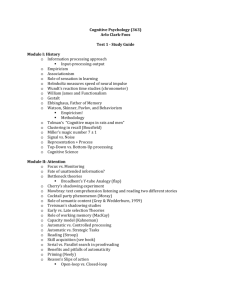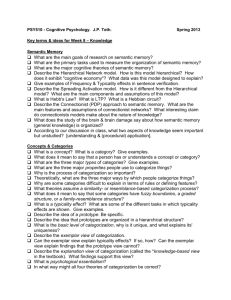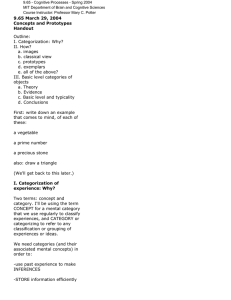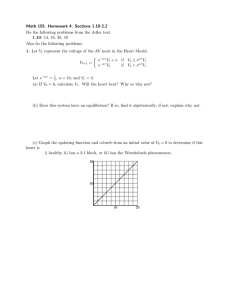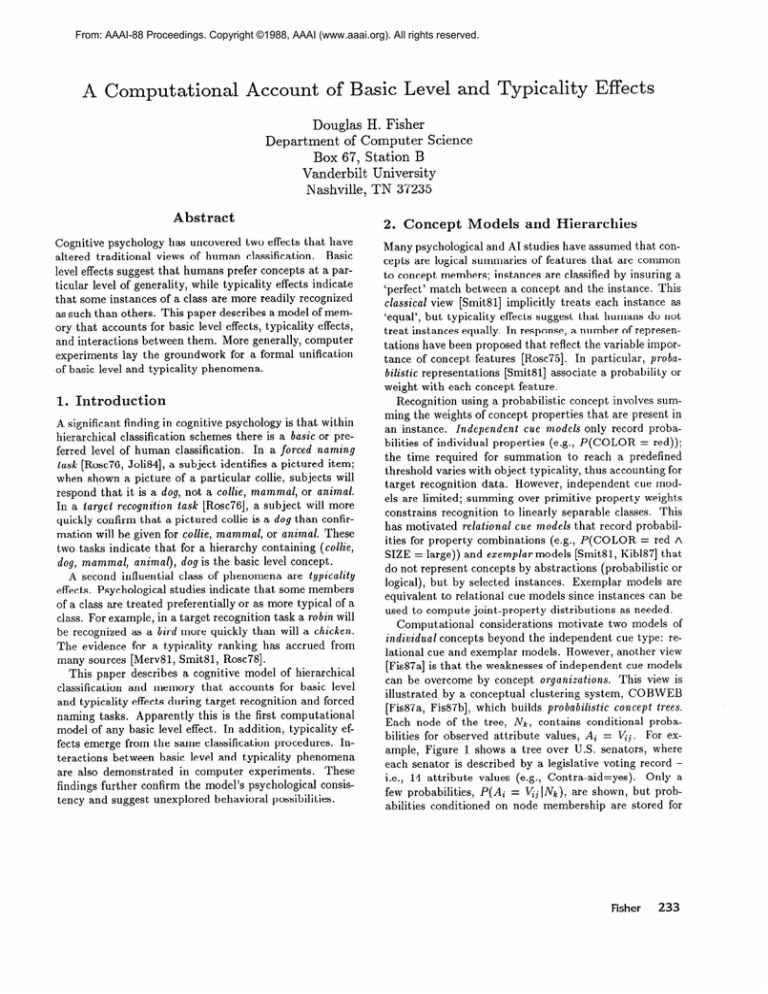
From: AAAI-88 Proceedings. Copyright ©1988, AAAI (www.aaai.org). All rights reserved.
A Computational Account of Basic Level and Typicality Effects
Douglas H. Fisher
Department of Computer Science
Box 67, Station B
Vanderbilt University
Nashville, I’N 37235
Abstract
Cognitive psychology has uncovered two effects that have
altered traditional views of human classification.
Basic
level effects suggest that humans prefer concepts at a particular level of generality, while typicality effects indicate
that some instances of a class are more readily recognized
as such than others. This paper describes a model of memory that accounts for basic level effects, typicality effects,
and interactions between them. More generally, computer
experiments lay the groundwork for a formal unification
of basic level and typicality phenomena.
1. Introduction
A significant finding in cognitive psychology is that within
hierarchical classification schemes there is a basic or preferred level of human classification. In a forced naming
tusk [Rosc~~, Joli84], a subject identifies a pictured item;
when shown a picture of a particular collie, subjects will
respond that it is a dog, not a collie, mammal, or animal.
In a target recognition tusk [Rosc~~], a subject will more
quickly confirm that a pictured collie is a dog than confirmation will be given for collie, mammal, or animal. These
two tasks indicate that for a hierarchy containing (collie,
dog, mammal,
animal), dog is the basic level concept.
A second influential class of phenomena are typicality
effects. Psychological studies indicate that some members
of a class are treated preferentially or as more typical of a
class. For example, in a target recognition task a robin will
be recognized as a bird more quickly than will a chicken.
The evidence for a typicality ranking has accrued from
many sources [Merv81, Smit81, Rosc78].
This paper describes a cognitive model of hierarchical
classification and memory that accounts for basic level
and typicality effects during target recognition and forced
naming tasks. Apparently this is the first computational
model of any basic level effect. In addition, typicality effects emerge from the same classification procedures. Interactions between basic level and typicality phenomena
are also demonstrated in computer experiments. These
findings further confirm the model’s psychological consistency and suggest unexplored behavioral possibilities.
2. Concept
Models
and Hierarchies
Many psychological and AI studies have assumed that concepts are logical summaries of features that are common
t*oconcept members; instances are classified by insuring a
‘perfect’ match between a concept and the instance. This
classical view [Smit81] implicitly treats each instance as
‘equal’, but typicality effects suggest that humans do not
treat instances equally. In response, a number of representations have been proposed that reflect the variable importance of concept features [Rosc75]. In particular, probubilistic representations [Smit81] associate a probability or
weight with each concept feature.
Recognition using a probabilistic concept involves summing the weights of concept properties that are present in
an instance. Independent
cue models only record probabilities of individual properties (e.g., P(COLOR = red));
the time required for summation to reach a predefined
threshold varies with object typicality, thus accounting for
target recognition data. However, independent cue models are limited; summing over primitive property weights
constrains recognition to linearly separable classes. This
has motivated relational c’zLemodels that record probabilities for property combinations (e.g., P(COLOR = red A
SIZE = large)) and exemplar models [Smit81, Kib187] that
do not represent concepts by abstractions (probabilistic or
logical), but by selected instances. Exemplar models are
equivalent to relational cue models since instances can be
used to compute joint-property distributions as needed.
Computational considerations motivate two models of
individual concepts beyond the independent cue type: relational cue and exemplar models. However, another view
[Fis87a] is that th e weaknesses of independent cue models
can be overcome by concept organizations.
This view is
illustrated by a conceptual clustering system, COBWEB
[Fis87a, Fis87b], which builds probabilistic concept trees.
Each node of the tree, Nk, contains conditional probaFor exbilities for observed attribute values, Ai = Kj.
ample, Figure 1 shows a tree over U.S. senators, where
each senator is described by a legislative voting record i.e., 14 attribute values (e.g., Contra-aid=yes).
Only a
few probabilities, P(Ai = V&]Nk), are shown, but probabilities conditioned on node membership are stored for
Fisher
233
formulated category utility, which presumes that the ba
sic level maximizes ‘predictive ability’. For example, very
few correct predictions can be made about an arbitrary
animal, but those that can be made (e.g., animate) apply to a large number of objects. In contrast, knowing
something is a robin assures many predictions, but they
apply to a small number of objects. The basic level concept (e.g., bird) is where a tradeoff between the expected
number of correct predictions (e.g., ‘has-feathers, beaks,
flies) and the proportion of the environment to which the
predictions apply,
P(Nk)E(#
correct predictions]l\rk),
is maximized. If P(Ai = V&lNk) is the probability that
an attribute value will be predicted and this prediction is
correct with the same probability then this measure can
be further formalized as:
fV%)xi cj f’(Aa= &jlNk)2.
Figure 1: Probabilistic
tree of senate voting records
each attribute value. Values along certain attributes (e.g.,
Budget-cuts) tend to distinguish members of a subclass
(N2) from a higher-level node (‘conservatives’), although
there must be agreement on other attributes (e.g., Contraaid) for objects to have been grouped together under ‘conservatives’. Object classification proceeds along a path of
best matching nodes - i.e., those that maximize a summation of individual attribute value probabilities.
Probabilistic concepts can be organized so as to optimize
prediction of a single ‘teacher-specified’ (perhaps nonlinear) class attribute as with ID3 [Quin86] decision trees.
However, COBWEB does not regard any attribute as special - rather, COBWEB trees facilitate good prediction
along many attributes. In theory, probabilistic concept
trees capture the the same information found in relational
cue or exemplar models. Ideally, the tree should capture
joint probabilities that occur most frequently or are most
‘important’, thus improving classification accuracy and/or
efficiency. Probabilistic concept trees are best viewed as
efficient implementations of exemplar and relational cue
models, rather than as alternatives to them. This view
opens the way for a unified account of ’basic level and typicality effects - behaviors traditionally treated as disparate
because of distinctions drawn between representations of
individual concepts (i.e., the scope of typicality) and concept hierarchies (i.e., the scope of basic level effects).
3. Hierarchical
Classification
Basic level effects suggest that there is a preferred level
in human classification hierarchies.
Several measures
[Rosc~~, Jone83] for predicting the basic level have been
proposed. Most recently, Gluck and Corter [Ghc85] have
234
Cognitive Modeling
Gluck and Corter verify that category utility correctly predicts the basic level (as behaviorally identified by human
subjects) in two experimental studies [Hoff83, Murp82J.l
COBWEB uses category utility as a partial matching function to incrementally guide object incorporation
at each successive level of a classification tree. Despite
its psychologically-motivated
underpinnings, COBWEB’s
strict top-down classification procedure does not jibe with
findings that an intermediate or basic ‘entry point’ is preferred by humans. To account for basic level effects the
classification scheme used by COBWEB is modified along
two dimensions of classification [Rosc~~]. The horizontal dimension is concerned with object placement among
contrasting categories at the same tree level. The vertical dimension is concerned with object placement among
categories at various levels of generality.
3.1.
The
Horizontal
Dimension
A number of systems [Lebo82, Kolo83] use attribute-value
indices to constrain classification along the horizontal dimension. Indices filter out nodes that bear little similarity
to a new object. A similar approach can be developed in
the COBWEB framework. In particular, the best host for
a new object is the category that maximizes
P(Nk)
xi
P(Aa
= Kj lNk)2.
3-2
This measure favors the class whose attribute-value distributions are most reinforced by the new object. This
function is not guaranteed to identify the same best host
as 3-1, but empirical analyses indicate that there is very
close agreement [Fis87a]. Using Bayes rule, 3-2 equals:
‘Category utility is actually the expected &crease in correct predictions. However, for our purposes, 3-1 is equivalent.
P(MammaljWarm-bloo
Figure 2: Index placement along the ‘vertical’ dimension
of Vij
Intuitively, P( Nk IAa = Vij) is the predictiveness
towards class Nk, while P(Ai = VijlNk) is the predictubility of Vij among Nk members. P(Ad = Vij) is Vij’S predictability at the root of a classification tree. P(A; = V;rj)
resides at the root, P(Ai = &j ]Nk) at Nk, and P(Nk IAi =
Vij) weights the index between the root and Nk.
3.2.
The
Vertical
tree to test basic level effects
in practice 3-4 closely approximates 3-3. Classification of
an object, 0, is summarized by:
Dimension
Classification efficiency can also benefit from indices that
‘jump’ levels of a hierarchy. In particular, attribute value
indices are directed at nodes that maximize the collocation
[Jone83] of Ej: P(Nk IAa = V;rj)P(Aa = V;:j]Nk). This is
a tradeoff between the predictiveness and predictability
of Vaj with respect to Nk. Collocation-maximizing nodes
tend to be the most specific nodes for which a value is still
significantly predictive.
Figure 2 illustrates how indices may skip levels. The
collocation for Backbone
is maximized at Vertebrates:
P(Vertebrate]Backbone)
x P(Backbone/Vertebrate)
=
1.0 x 1.0 = 1.0. However, the index for warm-blooded
is directed at the subordinate node Mummuds since collocation is maximized there: 0.67 x 0.98 = 0.66. Moreover,
each node [e.g., Vertebrates) is the root of its own subtree; indices &hose probabilities are conditioned on subnode membership are also defined [Fis87a]. However, in this
paper there is little need to detail the recursive case.
After adding variance on the vertical dimension, recognizing an object 0 = {Al = Vljl, A2 = V2jz, . . ..A.
=
Vmjm} is a matter of finding the node that maximizes
total-predictiveness
Figure 3: Partially-indexed
= Ci
P(NkIAi
= Kj).
3-4
Intuitively, this is the node that is most predicted by the
object’s attribute values. Because indices are directed at
collocation maximizing nodes, P(Ai = Qj ]Nk) tends to be
high (e.g., close to 1.0). In addition, P(Ai = Kj) is constant across all nodes. For these reasons, P(Aa = I$) and
P(Ai = Vij ]Nk) have little impact on best host selection;
FUNCTION Classify (0, Root [of tree])
total-predictiveness(Nk)
+O for each Nk
FOR each L$j (E 0)
FOR each L$j index from Root (to Nk>
increment total-predictiveness(Nk)
by P( Nk IAi = Kj 3Root)
Best + N with max[total-predictiveness(Nk.1
THEN RETURN(Best)
IF terminate-condition
ELSE Classify
(0, Best)
Recursion may terminate when a leaf is reached or when
a desirable prediction can be made with certainty.
4. An Account
of Basic
Level Effects
The indexing scheme’s consistency has been demonstrated
with findings from two psychological studies of basic level
effects. In one study [Hoff831 subjects learned a classification tree over ‘nonsense’ objects like the one shown
in Figure 3. Each class (node) had a ‘nonsense’ name
that subjects used to identify class membership in target
recognition tasks. Objects were defined in terms of three
attributes: the shape of the inside subcomponent with values square, triangle, star, or circle (encoded as 0, 1, 2, and
3, respectively); the outer shape with (encoded) values of
0 and 1; and the shape of the bottom with values 0, 1, 2,
and 3. For the tree of Figure 3 subjects consistently ‘preferred’ level 2 (e.g., Nz); the root is level 0. In addition
to this tree, two separate subject groups were trained and
tested on trees with different basic levels.
Fisher
235
The trees were encoded as probabilistic concept trees
as shown for the leftmost portion Figure 3’s tree. Value
probabilities are only shown at nodes where the value’s
The object {OUTER = 0,
collocation is maximized.2
BOTTOM = 0, INSIDE = 0) is first recognized with respect N2 since this node maximizes 3-4: P(N2lOUTER=
0) + P(N211NSIDE= 0) = 0.5 + 1.0 = 1.5.
For each of the three variants of the Hoffman and
Ziessler study, the model identified objects with respect to
the appropriate basic level node. The model is also consistent with experiments by Murphy and Smith [Murp82].
-
Letter
String
E
A
-
B
5. An Account
of Typicality
5.1.
Typicality
and Intra-Class
Similarity
Rosch and Mervis used the ‘nonsense’ strings of Table la
to demonstrate the relation between typicality and intra(within-) class similarity. Members of category A vary
in the extent that they overlap with other members of
the same class. For example, on average the symbols of
‘QBLFS’ appear in 2 other strings of class A, while the
symbols of ‘HMQBL’ are shared by 3.2 other members of
class A. The inter-class overlap between members of A and
B is constant (i.e., no overlap). Subjects learned to distinguish categories A and B and then participated in target
recognition tasks for members of A. Recognition time decreased as within-class overlap increased, supporting the
hypothesis that typical instances shared more properties
with other members of the same class.
To model these effects some presumptions must be made
about how categories A and B can be hierarchically structured. This did not pose a problem in modeling basic level
effects, since classification trees were explicitly taught. In
contrast, typicality studies assume that ‘flat’ categories
are taught, but the model assumes that they are stored as
a hierarchy of probabilistic concepts. At least two principles might dictate the hierarchical organizations used by
humans to encode A and B. Subjects may segregate instances based entirely on the external label (A or B) or
they may base an organization, as COBWEB does, on the
similarity ‘of objects irrespective of external label. Presumably, these represent the extremes of possible organizational principles. Conveniently, since there is no over2The level 1 nodes do not maximize collocation for any value. In
COBWEB such a node would not be created during concept formation or would be removed once all arcs to it were lost. However, the
Hoffman and Ziessler study trained subject’s on this classification
(i.e., a tutored learning task) - the objective here i,s to simply test
recognition on an existing tree, regardless of how it was learned.
236
Cognitive Modeling
lap
low
“
med.
“
high
“
-
Inter
Over-
Typicality
lap
ZKDWN
(14
(3
RVGZK
GZKDW
-
Letter
String
4KCTG
GKNTJ
4KC6D
HPNSJ
HPCGB
HPNWD
BSJKT
8SJ3G
SUJCG
4uzc9
4UZRT
MSZR5
JXPHM
QBLFS
XPHMQ
MQBLF
PHMQB
HMQBL
CTRVG
TRVGZ
VGZKD
Effects
Humans also exhibit preferences along the horizontal dimension as evidenced by typicality studies. In this regard,
the indexing scheme is consistent with findings by Rosch
and Mervis [Rosc75]; they demonstrate that typicality increases with the number of features shared with other objects of the same class and varies inversely with the number
of features shared with members of contrasting classes.
Intra
Over-
high
“
med.
“
low
“
zow
“
med.
“
high
‘<
Table 1: Letter strings used to test typicality.
lap between categories A and B, COBWEB’s approach of
grouping similar objects results in the same classes (at the
top level) as those based solely on external label.
The tree of Figure 4 classifies instances with respect to
the node that maximizes 3-4; this is N1 for each class A
member. At Nl a prediction can be made that a recognized instance is in class A since P(Cla.ss=A(N1) = 1.0.
However, symbols that are relatively unique among class
A members will cause certain instances to activate arcs to
subordinate nodes. In turn, this will detract from the
total evidence with which N1 is predicted.
For example, ‘HMQBL’ h as symbols common to most other class
A members and it predicts Nl with a score of 4, while
‘QBLFS’ has several relatively unique symbols, which reduces prediction of N1 to 2. A strong assumption of the
model is that the time required to reach a node is inversely
proportional to the total predictiveness towards that node.
Simulated time is computed as
time = distance/rate
= l.O/total-predictiveness,
The distance between any two nodes that are connected
by one or more indices is assumed to be 1.0. ‘HMQBL’ is
recognized in 1.0/4 = 0.25 time units. Figure 5 indicates
that in both the human and simulated case, instances with
greater intra-class overlap are recognized more quickly.
5.2.
Typicality
and Inter-Class
Similarity
Rosch and Mervis explored the impact of inter- (between) class similarity using the data of Table lb; within-class
overlap was held constant for class A members, but the
extent to which class A members overlapped with B varied from 0 (‘HPNWD’) to 1.3 (‘4KCTG’). Subjects were
taught to distinguish categories A and B; category A instances that shared few symbols with strings in category.
B were recognized more quickly (i.e., were more typical).
llooj
n
Human Response Time (ms)
P(l .O)
H(l .o)
M(l .o)
800
1
0
0.5
1
1.5
Simulated Time
Figure 5: Simulated and human recognition times of letter
strings
nteractions
Between
Typicality
EfFects
Figure 4: Partial tree that models typicality as function
of intra-class similarity
Fisher [Fis87a] used two classification trees to test the
indexing scheme: one segregated categories A and B
into different subtrees and the second tree was formed
by COBWEB, which grouped instances based on similarity. Recognition using both trees agreed with Rosch
and Mervis’ findings. Figure 6 shows part of the indexed
tree produced by COBWEB. Inter-class similarities tend
to diffuse evidence across lateral subtrees or a value may
not be predictive of any subnode (i.e., collocation is maximized at the root). For example, HPNWD predicts N14
with a total predictiveness of 2.67 at which point a prediction of category A can be made. In contrast, 4KCTG
predicts Nl with a score of 1.8; K predicts a subordinate
node, and G and T are not predictive of any node. Even
when recognition is made with respect to Nl, a prediction of class membership (A or B) cannot be made with
certainty, causing the classification process to recurse.
5.3.
Summary
A strong assumption of the computer model is that the
time to transit from one node to a descendent is inversely
proportional to the total predictiveness of attribute value
indices that are activated during recognition. The model
predicts that objects with less intra-category similarity
will be recognized slowly (i.e., be less typical) because rela
tively unique attribute values will diffuse index activation
across several levels (i.e., the vertical dimension) of the
classification tree. Instances with high inter-category similarity will be be less typical because common inter-class
values will diffuse activation across lateral subtrees or will
not be predictive at all ( i.e., the horizontal dimension).
ask
Level
and
Studies by Jolicour, Gluck, and Kosslyn [Joli84] qualify
the human preference for the basic level. In particular,
an instance (e.g., a particular chicken) may be sufficiently
atypical of its basic level class (e.g., bird) that it will be
first recognized as an instance of a subordinate class (e.g.,
chicken).
The model explains the impact of atypicality on
basic level preference. Low intra-category overlap results
in greater prediction of subordinate nodes. In addition,
there is a simultaneous decrease in prediction of the basic
level no‘de for atypical objects due to less intra- and more
inter- category overlap. These tendencies may coact so
that classification is initiated at a subordinate level. Unfortunately, experimental results in easily encoded artificial domains are lacking. However, Fisher [Fis87a] gives a
speculative demonstration of the model’s consistency in a
domain of thyroid patient case histories. Several cases are
first classified at a subordinate node; these are the most
atypical cases by the intra- and inter- similarity criteria.
A second interaction between basic level and typicality
effects is suggested by the model. Traditionally, target
recognition tasks that test for typicality have focussed on
typicality with respect to a basic level category [Rosc75].
Because classification usually passes through the basic
level, an expectation is that recognition with respect to
a subordinate node will be mediated by the the object’s
typicality to the basic level, as well as the subordinate
node. For example, in the domain of congressional voting records, the tree of Figure 1 shows that N2 is subordinate to ‘conservatives’. Nz classifies objects that tend
to be atypical conservatives like ‘Hollings’ (a southerndemocrat).
As expected, ‘Hollings’ is recognized slowly
as a ‘conservative’ since he is (relatively) atypical of this
class. However, ‘Hollings’ is also slow to be recognized as
a member of N2 even though he is typical of this class (by
intra- and inter- similarity criteria)! The model predicts
Fisher
237
References
[Fis87a] Fisher, D. Knowledge
acquisition
via incremencZustering, Technical report 87-22 (doctoral
dissertation), Department of Information and Computer
Science, University of California, Irvine, (1987).
tad conceptuad
P( 1.0)
[Fis87b] Fisher, D. K nowledge acquisition via incremental
conceptual clustering. Machine, Learning 2 (1987)) 139172.
HPNWD
4KCTG
Figure 6: Partial tree that models typicality as function
of inter-class overlap.
that atypicality with respect to a basic level concept can
offset advantages associated with subordinate node typicality. Apparently, there is no psychological data to support this hypothesis, but it may bolster, weaken, or alter
claims for hierarchical representations of category structure should psychological-data be forthcoming:
7. Concluding
Remarks
This paper presents a memory model that is consistent
with data on human basic level and typicality effects. The
model draws significantly from previous investigations of
the basic level, notably Gluck and Corter [Gluc85] and
Jones [Jone83]. However, this work demonstrates how
explicit calculation can be ‘compiled’ into an indexing
scheme. Apparently, this is the first computational account of any basic level effect. In addition, the model accounts for typicality data and basic level/typicality interactions. The model also predicts a previously unexplored
interaction between basic level and typicality effects. Finally, the COBWEB framework offers a unique opportunity for speculating on the evolution of basic level and
typicality effects during learning. Learning- with indices is
reported in [Fis87a], but it has been downplayed here so
that a clear picture of the static memory structure could
be described and evaluated. Furthermore, there is little
psychological data on which to base claims for basic level
and typicality development.
Thus, there are several areas
in which the model can guide experimentation.
Acknowledgements
This work owes much to Dennis Kibler and Pat Langley, as
well as early discussions with Mark Gluck and Jim Corter.
AAAI reviewers helped clarify exposition.
238
Cognitive Modeling
[Gluc85] Gluck, M., and Corter, J. Information, uncertainty, and the utility of categories. Seventh Annual Conference ofthe Cognitive Science Society (Irvine, CA, 1985))
Academic Press, Orlando, FL, 283-287.
[Hoff831 Hoffman, J., and Ziessler, C. Objectidentifikation
in kunstlichen begriffshierarchien. Zeitscrift fur Psychologie 16 (1984)) 243-275.
[Joli84] Jolicoeur, P., Gluck, M., and Kosslyn, S. Pictures
and names: making the connection. Cognitive Psychology
16 (1984)) 243-275.
[Jone83] Jones, G. Identifying basic categories. Psychological Bulletin 94 (1983)) 423-428.
[Kibl87] K’
1bl er, D., and Aha, D. Learning representative
exemplars of concepts. Fourth Internationad
Workshop on
Machine Learning, (Irvine, CA, 1986)) Morgan Kaufmann,
Los Altos, CA, 513-517.
[Kolo83] K o 1o d ner, J. Maintaining organization in a dynamic long-term memory. Cognitive Science 7 (1983)) 243280.
[Lebo82] Lebowitz, M. Correcting erroneous generalizations. Cognition and Brain Theory 5 (1982)) 367-381.
[Merv81] Mervis, C., and Rosch, E. Categorization of natural objects. Annuad Review of Psychology 32 (1981)) 89115.
[Murp82] Murphy, G., and Smith, E. Basic level superiority in picture categorization. Journal of Verbal Learning
and Verbal Behavior 21 (1982)) l-20.
[Quin86] Quinlan, J. R. Induction of decision trees. Machine Learning
1 (1986)) 81-106.
[Rosc75] Rosch, E., and Mervis, C. Family resemblances:
studies in the internal structure of categories. Cognitive
Psychology 7 (1975)) 573-605.
[Rosc76] Rosch, E., Mervis, C., Gray, W., Johnson, D.,
and Boyer-Braem, P. Basic objects in natural categories.
Cognitive Psychology,
8 (1976)) 382-439.
[Ftosc78]Rosch, E. P rinciples of categorization.
In CogE. Rosch and B. Lloyd, Eds.,
Lawrence Erlbaum, Hillsdale, NJ (1978)) 28-49.
nition
and
Categorization,
[Smit81] Smith, E., and Medin, D. Categories
and Concepts, Harvard University Press, Cambridge, MA (1981).


